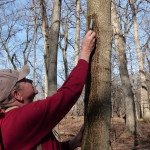Most woodpeckers are homebodies. Downy, hairy, red –bellied and most other woodpeckers are nonmigratory. Search a woodsy area and chances are they can be spotted or heard year round. Many will come to the backyard for a suet feast. Most woodpeckers are easy to observe and identify. They are noisy and move frequently making them easy to spot. They often call and drum as they move from tree to tree. The yellow-bellied sapsucker is an unusual woodpecker. It’s migratory in part of the country, secretive and challenging to find. Patient observation helps locate one hugging an April tree in the upper Midwest.
This colorful bird is about the size of the familiar hairy woodpecker. Despite its name the yellow belly is hard to see. More visible is a red crown and white stripe down the wings. The bird nests and summers from the Yukon across the continent to New England. Some spend the entire year in southeastern states down to southern Mexico, but many migrate north to nest. Winding Pathways is in Iowa where sapsuckers only pass through. They are most common in April.
Although more secretive than other woodpeckers sapsuckers are fairly common suburban and woodland birds. They leave unmistakable evidence of their presence.
Sapsuckers ingest sap and eat the insects that are attracted to this sticky substance. Birds drill holes in thin bark, especially of maples, birches and pines. Sap oozes out of the wound, and the birds return for nutritious dining. Usually the holes, called wells, are perfectly round with several forming a horizontal line. Sapsucker wells rarely harm a tree, although scars can remain on the bark for several years.
An outstanding information source for yellow-bellied sapsuckers and hundreds of other bird species is a website sponsored by the Cornell Laboratory of Ornithology. Go to allaboutbirds.org and enter in the species of interest. Photos, videos, maps, sound recordings and interesting tidbits of information will appear. The lab also offers a free smart phone bird identification app. Click on the website tab for information.


